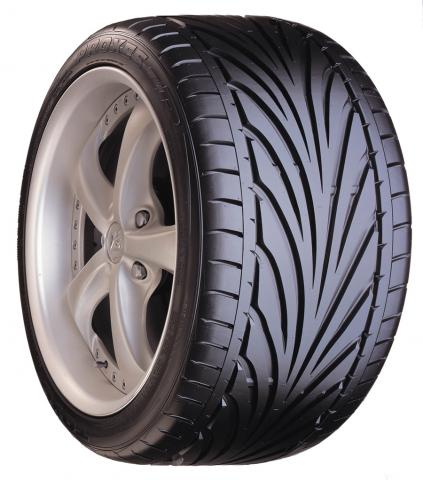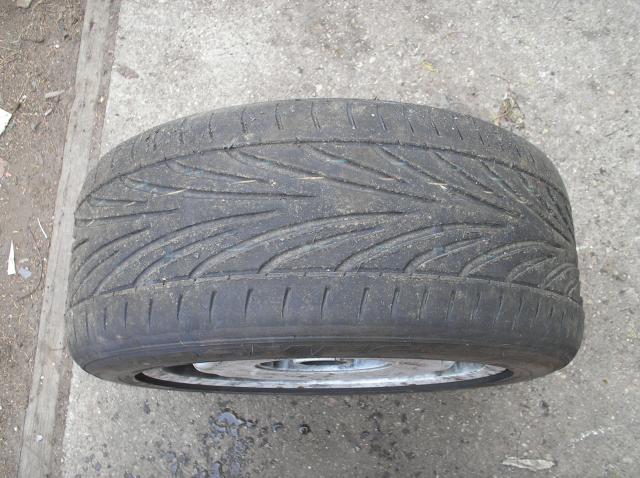
Toyo Proxes T1R
OK, so here's what Toyo have to say about the T1R:
The Proxes T1-R is the natural choice for enthusiastic drivers and is now available in an even wider range of sizes. The Proxes T1-R boasts a special performance compound and tread pattern which gives which gives incredible road holding in all conditions, especially in the wet. The V-Shaped grooves in the tread pump water away allowing the rubber to grip the road. These are bounded by circumferential grooves which allow the Proxes T1-R to give you even better wet grip whilst being quieter and longer lasting. These design elements are not just practical, they also make the tyre look spectacular on any car.
The Proxes T1-R is available in a range of popular high performance sizes from 14" up to 21".
For a full range of sizes, go to the Toyo site here: www.toyo.co.uk
From a more personal perspective, we've been using the T1R for three years in the JEC Toyo Tires Jaguar XJS Championship.
The heaviest car is on the smallest tyres, 1510kg on 225/50/16 tyres, the largest permitted by the regulations.
The other 2 cars, the 1410kg V12 and the 1380kg wild six-pot have both run 235/45/17 and 245/45/17 tyres.
Proportionately speaking, width has always led to an improvement in lateral grip and reduced braking distance. Of course much depends on the car setup, but for the same setting it has generally held true.
That said, the car's handling characteristics changed with each set, tending more towards understeer with an increase in grip, and the step from 235/45 to 245/45 compromised acceleration.
The tyre generally speaking lasts very well. A single set lasted our class D car for an entire race season, including some serious test miles at every track. The class E car likewise lasted almost a full year on one set of 235s. The V12 didn't, the driver likes a powerslide or two and they can be chewed to bits in a single race if you want to drift. To make them last like that did require careful pressure setup, but they are surprisingly durable.
Load rating on these is important. The 225 isn't really up to the task of the weight it has to carry for our class D XJS, when really pushed on a properly set-up car it will start to destroy itself by pulling pieces of the tread off. We think this is simply a result of being forced to run inadequate tyres by the regulations, rather than any fault in the tyre itself.
For track use it is vital that they be scrubbed before use. Full tread is good in the wet, but for dry use we take them down to 5mm. Beyond that is a question of personal preference, some drivers start at 4 or even 3mm!
What profile? With the big, heavy Jags, we found the taller the better, within reason, the additional sidewall compliance was helpful. For example the blue machine was clearly faster on 50 profile tyres than 40. The tyre is relatively low grip, and will squeal and slide before the carcass deforms.
It is very forgiving, loses grip with a lot of warning and an engraved invitation, progressively and with a polite apology.
Pressure? There is no substitute for proper car setup and a driver who can offer proper feedback, but after a few thousand test miles we settled on aiming for 38-40psi hot. For the 15-minute races we run, that allowed a full-tilt assault on the race without the tyre going off. How you get to 40 hot is up to you.
What about all that weaving on the green flag lap? On a T1R no, don't bother. It puts on its pressure and temperature fast, but it isn't actually bad cold, first lap performance is good immediately, it doesn't need switching on, you can go straight on it.
Go much above 40 and all the grip disappears, they do go off in a hurry with every additional degree.
The Anglesey exception - they hate the tarmac at the Anglesey circuit. We don't know why exactly, but there is so little grip there on this it may as well be raining, and we say as multiple race winners there.
Wet weather? In an outright monsoon they will crucify the other two tyres if you're on nice new, soft, full-tread rubber, they are very good. Get them a bit old and they suffer, and in some conditions the other two will show you up, but for standing water these are great. If it's greasy, or damp, or even wet, stick to your race rubber, but if Noah starts building an Ark, this is the one we'd choose. They are very good in the wet, but they can be out-done by stickier compounds.
Wet weather pressures? We go at 40psi cold, they aren't going to warm up, and it works.
Should you go out in the wet and it dry out, your full-tread rubber will cook, roll and be ruined fast.
We loved the T1R. It was predictable, surprisingly grippy when used properly, great in the wet, and it lasted well.
Prices are good too, even scrubbed and fitted they are now so freely available that they can be on the car for 30% less than you can buy an R1R, and they will likely last twice as well.
It is of note that some XJS drivers report it suits them every bit as much as the newer, stickier R1R, which demands more precise setup.
For performance per £, they are our clear favourite.

225/50/16 after half a season, including test miles. Started life scrubbed to 5mm, but as you can see, no rolling of tread or uneven wear. The blue-ish tint to the outer edge is normal, this one has been seriously abused.

Here's the promo video on Youtube:
http://www.youtube.com/watch?v=dMdy-U140O8
But the "surprisingly low noise" is nonsense, push these and they squeal like that scene from Deliverance.